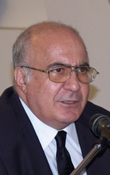
Vasilescu Sorin, architect, professor - “Ion Mincu” University of Architecture, Bucharest.
Date of birth: June, 20. 1947. Bucharest. Education: “Ion Mincu” Institut of Architecture, 1973.
Professional retraining courses-the Institute of Architecture, Post-graduate courses, 1983-1984. Attendand and graduate of Andrea Palladio International Courses of Architecture and Studies, Vicenza 1988, 1990. Ph.D in Architecture, 1994.
Professional background: assistant 1973-1990, university lecturer 1990-1994, lecturer (higher degree) 1994-1997, professor, since 1997, head of university departament 1990-2000, chancellor of “Ion Mincu” University of Architecture, since 2000, lectures at Cultural and Scientific University, Bucharest 1986. School of Architecture in Strasbourg, 1990, the Faculty of Architecture, Chisinau (1991-1994), School of Architecture in Liége
and Tournay, Venetian Atheneum (1992), Romanian Institute of Humanist Culture in Venice(1992,1996), the Faculty of Architecture in Milan (1992, 1995), the Faculty of Architecture in Torino (1993,1995), Accademia di Romania in Rome, Kekcsemet, Hungary, 1997 etc.
Main architectural projects: “Manufacturers Hannover Trust” Bank in Bucharest, mosque in Lybia, design project for Dacia 1310, “Catargi House” renovation, Orthodox church in Techirghiol, Romanian Orthodox establishment in Jericho, Romanian Orthodox Church in Jerusalem, Orthodox church in Constanța;
Exhibitions, symposiums, biennal exhibitions of architecture: International Biennal of Architecture, Sofia 1986, Graziussi Galleries, Venice Biennal, 1992, project exhibition and lecture, Udine, Italy, 1996, Romanian Institute of Humanist Culture, Palazzo Correr Venice (1997). Accademia di Romania in Roma, etc..
Conference attending: Faculty of Architecture, Chisinau, Faculty of Architecture Moscow, 1994, Tg. Mures 1998, Arad 1999, the Union of Architects in Jerusalem, 2000; „Giulio Magni și Petre Antonescu” la Accademia di Romania, Roma, octombrie 2012; ”Arhitecți români în totalitarism ”– Muzeul Sutzu, 15 martie 2013; ”Un sfert de veac de la dărâmarea Mânăstirii Văcărești”, la Academia Română, București, octombrie 2014; „Interferențe arhitecturale româno-italiene în perioada interbelică”, la Accademia di Romania, Roma, mai 2014; „Arhitectura brâncovenească”, Centrul Cultural Român, New York , 3 octombrie 2014; Conferința „Karel Liman - arhitectul ceh al Casei regale a României”, la Biblioteca Națională, Praga, 28 inuarie 2015
Publications: “The History of Universal Architecture 1993”; “Totalitarian architecture” 1994; “A Dictionary of Modern Architects” (3 volumes, 1995), IAIM Publishing House, Bucharest; “Architettura totalitaria”; Notiziaro Italiano Publihsing House, Torino 1997, Articles in Romanian and foreign magazines of architecture (Web Magazine Ragionpolitica.it); Petre Antonescu, Ed.UAUIM, Bucureşti 2002; Notes for a history of architecture – Art Nouveau în Romania, Ed. Ramuri, Bucureşti 2005; Arhitectura Romei imperiale, Ed. Sinorom, Bucureşti 2008; Tropaeum Traiani, Ed. Sinorom, Bucureşti 2008; Art Nouveau in Romania, Ed. Sinorom, Bucureşti 2008; Fascist Italy Architecture, Ed. Arhitext, Bucuresti 2011; Architecture Nazi Germany, Ed.Arhitext, București 2012; Karel Liman, the Czech architect of the Royal House of Romania, Ed. Igloo, București 2013; Russian Stalinist architecture, Ed. Arhitext, București 2013; Monastery Văcărești (coautor), Ed. Monitorul Oficial, București 2014; Age civilization Brancoveanian
(coautor), Ed. Monitorul Oficial, București 2014
Social Activity: Member of Romanian Order of Architects, UAPR (member of honour); Member of Palladian Academy in Vicenza; Member of AEEA - European Association for Architectural Education in Strasbourg; member of Romanian Jockey Club, Member of University Senat, President of ICOMOS – The National Romanian Committee (2002-2006); Director of the School for Advanced Studies of Architecture and urbanism University "Ion Mincu" - Bucarest, (2004-2008), Preident of the Fundation Giulio Magni (>2008), President of National Committee of public Monuments (CNMFP) >2013.
Honours and Awards: The Order of Architects Award (1975), “Patriarchal Grand Cross” (2000); Chevalier (2000) and Officer (2004) of “Serviciul Credincios” National Order;Romanian Academy Award (2015)
Presentation Title:keynote Speech “On the city roof, another kind of urban space"The green roof”
Abstract
The works that I do as author or coauthor, are for me an opportunity to make some general meditations on the subject in case, without temptation and hope for global awareness of this intellectual approach. This also applies to the study done in collaboration with the young PhD architect Pietro Aureliano
Dorissa. This study is an attempt to treat as an architect, the complex relationships of interrelation between nature and architecture addressed in the context of the alienation of modern man due to rupture of nature , the general process of modern urban life dominated by barren " deserts of asphalt " as Hitler called them.
In this key I was approached this study, for which the choice was based on thinking big regarding the germination of new ideas, new forms, based both on certain rules of composition, to try to give a solution for acute problems linked a general lack of green spaces in contemporary urban housing.
To some extent this study deals with unresolved problems of living in a "post-postmodern" world. Such a topic gives us the opportunity to meditate on subjects that often resonate more or less harmonic. The thought of dwelling in a
context of increasingly distant nature, leads us from the beginning to the intricate and complex term of habitability and sends us to a fundamental study of Noica , entitled "Introduction to Housing of 2001" which begins with an imperative grievance : "Give us houses as our multiple humanity." It must be well understood that our proximity to figures such as philosopher Noica must be made to avoid falling into enormous and ridiculous, in a certain plan , which should in future be clarified , that of similarities and differences between approach, method , terms and concepts circulating both in philosophical language (often coherent in logic and shape ) and the architects (often non-coherent , illogical and lacking formal) . What the philosopher understands by the fundamental concept of habitation and alienation is similar but far from identical with what is understood by the architect.
